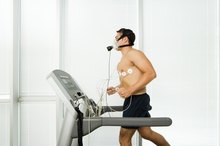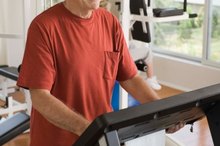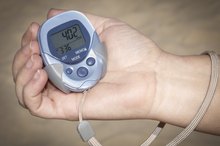What does fact checked mean?
At Healthfully, we strive to deliver objective content that is accurate and up-to-date. Our team periodically reviews articles in order to ensure content quality. The sources cited below consist of evidence from peer-reviewed journals, prominent medical organizations, academic associations, and government data.
- National Institutes of Health: Your Guide to Living Well with Heart Disease
- National Institutes of Health: Your Guide to Living Well with Heart Disease
- American Heart Association: Frequently Asked Questions
- American Heart Association: Develop a Physical Activity Plan for You
- American Heart Association: Be Safe While Being Active
The information contained on this site is for informational purposes only, and should not be used as a substitute for the advice of a professional health care provider. Please check with the appropriate physician regarding health questions and concerns. Although we strive to deliver accurate and up-to-date information, no guarantee to that effect is made.
How to Use a Treadmill for Exercise in Heart Patients
Exercise is safe for most patients who have heart disease, have experienced heart failure or have undergone heart surgery, according to the National Institutes for Health 1. Exercise can help strengthen the heart, lungs and muscles and improve stamina. Walking on a treadmill is an aerobic exercise that works your major muscle groups and causes your heart and lungs to work harder and more efficiently. Safe use of the treadmill for exercise requires starting slowing and working with your health care team to monitor your medical condition.
Talk to your doctor before starting a treadmill exercise program. Your doctor can tell you how much exercise is appropriate for you and help you understand the safest treadmill settings for you. Your doctor might perform a treadmill stress test to determine your capability for physical activity.
Submaximal Treadmill Test Protocol
Learn More
Purchase a treadmill or arrange to use one at a local gym or health facility. The treadmill should meet your immediate exercise needs and your long-term needs. Even though you will start your treadmill workout program using basic settings, you will increase your ability to use more advanced settings on the treadmill.
Schedule your treadmill workout using the American Heart Association physical activity guidelines, the simplest of which is 30 minutes, five days a week 345. Other AHA recommendations are to engage in a minimum of 150 minutes of moderate exercise each week, 75 minutes of vigorous exercise each week, or a combination of the two. You may also divide the recommended minutes into 10- to 15-minute sessions, two to three times each day.
How to Run Using Jeff Galloway's Run/Walk/Run Training Method
Learn More
Write your planned days and times on a calendar to help you stick to your exercise. The AHA recommends flexibility, such as more time exercising on weekends, walking on the treadmill while watching television and breaking up your daily time into smaller segments during the day.
Start slowly on your treadmill exercise program. Set moderate goals that you can reach and walk at an intensity that allows you to talk but not sing. Any time spent performing aerobic exercise is good for you and you will increase your ability to perform more vigorous exercise over time.
Take your heart rate before and after your treadmill workout by placing your second and third fingers of one hand on the blood vessel located on the inside wrist of your other hand. Feel for your pulse and count your heart rate for 15 seconds. Multiply the total heartbeats by four. Contact your doctor if your heart rate is below 50 or above 120 while at rest. Your heart rate during exercise should not exceed 30 beats per minute over your resting heart rate.
Warm up and cool down before and after your treadmill workouts. Walk slowly for 5 to 10 minutes and perform a few stretches.
Increase your time on the treadmill gradually and with the approval of your health care team, by aiming for 30 minutes a day. Your health care team also can instruct you on using the treadmill settings for speed, incline and beginning a custom workout program.
Write down information about your treadmill workouts in an exercise journal. Include your heart rates, the days and lengths of workouts and other information that helps your health care team monitor your health and your progress.
Tips
Work with your health care team or a physical therapist to design a workout plan for the treadmill. Drink plenty of water during your workouts.
Warnings
Ask your doctor or health care team the appropriate level for you to begin your treadmill workouts. Stop exercising immediately and contact your doctor if you feel chest pain, dizziness, blurred vision, profuse sweating, nausea, numbness in your limbs or excessive shortness of breath.
Related Articles
References
- National Institutes of Health: Your Guide to Living Well with Heart Disease
- University of Wisconsin Health: Exercise and Activity After Heart Surgery
- American Heart Association: Frequently Asked Questions
- American Heart Association: American Heart Association Guidelines
- American Heart Association: Develop a Physical Activity Plan for You
- American Heart Association: Be Safe While Being Active
Resources
Tips
- Work with your health care team or a physical therapist to design a workout plan for the treadmill. Drink plenty of water during your workouts.
Warnings
- Ask your doctor or health care team the appropriate level for you to begin your treadmill workouts. Stop exercising immediately and contact your doctor if you feel chest pain, dizziness, blurred vision, profuse sweating, nausea, numbness in your limbs or excessive shortness of breath.
Writer Bio
Gail Sessoms, a grant writer and nonprofit consultant, writes about nonprofit, small business and personal finance issues. She volunteers as a court-appointed child advocate, has a background in social services and writes about issues important to families. Sessoms holds a Bachelor of Arts degree in liberal studies.







